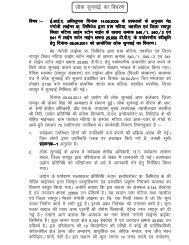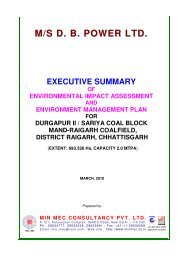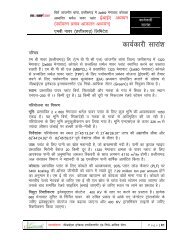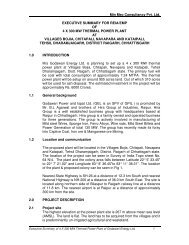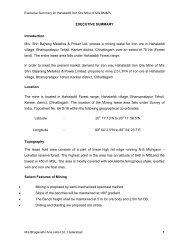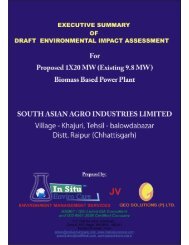Gopal Sponge & Power Private Limited - Chhattisgarh Environment ...
Gopal Sponge & Power Private Limited - Chhattisgarh Environment ...
Gopal Sponge & Power Private Limited - Chhattisgarh Environment ...
Create successful ePaper yourself
Turn your PDF publications into a flip-book with our unique Google optimized e-Paper software.
Executive summaryof Draft <strong>Environment</strong>al Impact Assessment Report<strong>Gopal</strong> <strong>Sponge</strong> & <strong>Power</strong> <strong>Private</strong> <strong>Limited</strong>Mini Integrated Steel Plant1.0 INTRODUCTIONM/s GOPAL SPONGE & POWER PVT LTD has proposed to establish aPelletizing Plant (5,00,000 TPA), Blast Furnace (1,40,000 TPA), DRI Kilns (60,000TPA), Induction Furnaces (1,30,000 TPA), Rolling Mill (60,000 TPA), Sub MergedElectric Arc Furnace (30,000 TPA) & <strong>Power</strong> plant ( 46 MW - 4 MW through WHRB<strong>Sponge</strong> Iron, 2 MW through WHRB Pig Iron plant and 40 MW through AFBC) inMohda Village, Tilda Tehsil, Raipur District, Chattisgarh. The capital investmentof the proposed project is Rs. 400.0 Crores. The following will plant configurationsand production detailsDETAILSPLANT Annual ProductionCONFIGURATION Capacity (TPA)Pelletization of Iron Ore ----------- 5,00,000Pig Iron through Blast Furnace Route 1 x 200 M 3 1,40,000<strong>Sponge</strong> iron through DRI Route 1 x 200 TPD 60,000Steel ingots/ billets through induction furnace 4 x 10 MT/heat 1,30,000Rolled products through Rolling Mill 1 x 200 TPD 60,000Manufacturing of Ferro Alloys through SEAF 2 x 9 MVA 30,000Total <strong>Power</strong> Generation46MWa) through WHRB from <strong>Sponge</strong> iron plant 1 x 4 MW 4 MWb) through WHRB from Pig Iron Plant 1 x 2 MW 2 MW<strong>Power</strong> Generation through FBC1 x 10 MW&1 x 30 MW40MWPioneer Enviro Laboratories & Consultants <strong>Private</strong> <strong>Limited</strong>, Hyderabad, haveprepared Draft Rapid <strong>Environment</strong>al Impact Assessment (DREIA) report for theproposed Mini Integrated Steel Plant by incorporating the TOR approved byMinistry of <strong>Environment</strong> & Forests, New Delhi. The report contains detaileddescription of the followingCharacterization of status of environment with in an area of 10 km radiusfrom the project site for major environmental components including air,water, noise, soil, flora, fauna and socio-economic environment.Assessment of air emissions, liquid waste and solid waste from the proposedproject along with the noise level assessment.- :: 1 :: -
Executive summaryof Draft <strong>Environment</strong>al Impact Assessment Report<strong>Gopal</strong> <strong>Sponge</strong> & <strong>Power</strong> <strong>Private</strong> <strong>Limited</strong>Mini Integrated Steel Plant<strong>Environment</strong>al Management Plan comprising of emission control measuresproposed to be adopted in the proposed project, solid waste management,Greenbelt development.Post Project <strong>Environment</strong>al Monitoring.2.0 PROJECT DESCRIPTION1. The proposed project will be located in Mohda Village, Tilda Tehsil, RaipurDistrict, <strong>Chhattisgarh</strong>.2. Shivnath River is situated at a distance of 7.15 Km from the site. While anothersurface water source is River Kulhan flowing at the distance of 3.7 km away fromthe proposed site.3. Total land acquired is 100.0 acres4. There are no National parks / Wild life sanctuaries within 10 Km radius ofproject site.5. Presently acquired land is barren, no agricultural land or forest land comes underthe acquisition.6. The following major industries are situated with in 25 Km. radius.S.NO NAME OF THE INDUSTRY TYPE1. Aarti <strong>Sponge</strong> & <strong>Power</strong> <strong>Limited</strong> <strong>Sponge</strong> Iron Manufacturing2. Abhishek Steel Industries Induction and Rolling Mill3. Abhjeet Infrastructure <strong>Private</strong> <strong>Limited</strong> Coke Oven Plant4. Agrawal <strong>Sponge</strong> & <strong>Power</strong> <strong>Private</strong> <strong>Limited</strong> <strong>Sponge</strong> Iron Manufacturing5. Alankar Steels <strong>Private</strong> <strong>Limited</strong> Rolling Mill6. API Ispat & <strong>Power</strong>tech <strong>Private</strong> <strong>Limited</strong> Steel Plant7. Arsh Iron and Steel Pvt. <strong>Limited</strong> <strong>Sponge</strong> Iron Manufacturing unit8. Baldev Alloys <strong>Private</strong> <strong>Limited</strong> <strong>Sponge</strong> Iron Manufacturing unit9. Centuri Cements, Baikunth Cement Plant and Lime Stone Mines10. Chetan Industries <strong>Limited</strong> Rolling Mill11. Corporate ispat <strong>Limited</strong> Integrated Steel Plant12. Devi Iron & <strong>Power</strong> <strong>Limited</strong> <strong>Sponge</strong> Iron Manufacturing13. Drolia Electrocast private L:imited <strong>Sponge</strong> Iron manufacturing14. G.P. Ispat <strong>Limited</strong> Rolling Mill15. Gaurav Krishana Ispat <strong>Private</strong> <strong>Limited</strong> Rolling Mill16. <strong>Gopal</strong> <strong>Sponge</strong> & <strong>Power</strong> <strong>Private</strong> <strong>Limited</strong> <strong>Sponge</strong> Iron Manufacturing17. Hitech Abrasives <strong>Limited</strong> Steel Shots <strong>Limited</strong>18. Hi-Tech <strong>Power</strong> and Steel <strong>Limited</strong> <strong>Sponge</strong> Iron Manufacturing unit19. Ispat Godawari <strong>Limited</strong> Integrated Steel Plant- :: 2 :: -
Executive summaryof Draft <strong>Environment</strong>al Impact Assessment Report<strong>Gopal</strong> <strong>Sponge</strong> & <strong>Power</strong> <strong>Private</strong> <strong>Limited</strong>Mini Integrated Steel Plant20. Jaiswal Neco <strong>Limited</strong> Integrated Steel Plant21. Khetan <strong>Sponge</strong> & Infrastructure <strong>Private</strong> <strong>Limited</strong> <strong>Sponge</strong> Iron Manufacturing unit22. Maa Usha Urja <strong>Limited</strong> Biomass based <strong>Power</strong> plant23. Mahendra <strong>Sponge</strong> & <strong>Power</strong> <strong>Private</strong> <strong>Limited</strong> Steel Plant24. Maruti Ferrous <strong>Private</strong> <strong>Limited</strong> Induction Furnace unit.25. Nandan Steels and <strong>Power</strong> <strong>Limited</strong> Induction and Rolling Mill26. P.D. Industries <strong>Private</strong> <strong>Limited</strong> <strong>Sponge</strong> Iron Manufacturing unit27. Raghuvir Ferro Alloys <strong>Private</strong> <strong>Limited</strong> Ferro Alloys Manufacturing28. Raipur Rotocast <strong>Limited</strong>29. Rashmi <strong>Sponge</strong> & <strong>Power</strong> Ind. <strong>Limited</strong> Steel Plant30. S.K. Sarawagi & Co. <strong>Private</strong> <strong>Limited</strong> Steel Plant31. Saini Industries <strong>Limited</strong> Rolling Mill32. Sarda Energy <strong>Limited</strong> Integrated Steel Plant33. Saurabh Rolling Mill Rolling mill unit34. Shree Bajrang Metalics <strong>Limited</strong> Steel Manufacturing unit35. Shree Hare Krishna <strong>Sponge</strong> <strong>Private</strong> <strong>Limited</strong> Steel Manufacturing unit36. Shree Shyam <strong>Sponge</strong> and <strong>Power</strong> <strong>Limited</strong> <strong>Sponge</strong> Iron Manufactuirng37. SKS Ispat <strong>Limited</strong> Integrated Steel Plant38. South Asian Agro Industries <strong>Limited</strong> Biomass based <strong>Power</strong> Plant39. Steel Abrasives <strong>Limited</strong> Steel Shots40. Sunil <strong>Sponge</strong> & <strong>Power</strong> <strong>Private</strong> <strong>Limited</strong> <strong>Sponge</strong> Iron manufacturing41. Super Iron & Steels <strong>Limited</strong> Rolling Mill unit42. Ultratech Cements <strong>Limited</strong>, Hirmi Cement Plant and Lime Stone Mines43. Usha Fuels <strong>Private</strong> <strong>Limited</strong> Coke oven Plant44. Vandana Global <strong>Limited</strong> Integrated Steel Plant45. Vaswani Industries <strong>Limited</strong> Steel manufacturing unit3.0 DETAILS OF PROJECT3.1 RAW MATERIALSThe following will be the raw material requirement for the proposed Mini IntegratedSteel Plant.Raw MaterialConsumption(TPA)- :: 3 :: -Sources ofSupplyMethod ofTransportationPELLET PLANTIron ore fines 5,00,000 NMDC/ Orissa By covered trucksCoal 25,000 Imported By covered trucksBentonite 10,000 Open market By covered trucksSINTER PLANTIron ore fines 119454 Open market By covered trucksLimestone fines 14660 Open market By covered trucksDolomite fines 12217 Open market By covered trucksCoke breeze 10780 Imported Through seaMill scale 1255 Open market By covered trucksRMP Waste 3740 Open market By covered trucks
Executive summaryof Draft <strong>Environment</strong>al Impact Assessment Report<strong>Gopal</strong> <strong>Sponge</strong> & <strong>Power</strong> <strong>Private</strong> <strong>Limited</strong>Mini Integrated Steel PlantPIG IRONIron ore pelletsIn plant Through conveyor67200 generationBF coke 85400 Imported Through seaQuartzite 3500 Open market By covered trucksSinterIn plant By conveyors154000 generationManganese ore 2100 Open market By covered trucksSPONGE IRONIron ore Pellets 1,08,000 In plant Through conveyorgenerationCoal 78,000 SECL Through rail/roadDolomite 3,000 Open market By covered trucksINDUCTION FURNACES<strong>Sponge</strong> iron 60,000 Own generation ---Pig Iron 48,550 Own generation ---Scrap 39,000 Own generation/approved vendors---Ferro alloys 1,950 Own generation ---ROLLING MILLSteel ingots/ Billets 63,000 Own generation Through conveyorFurnace oil 1920 Authorized dealers Through tankersFERRO ALLOYSManganese ore 68920 Open market By covered trucksCoke /coal 22475 Open market By covered trucksChrome ore 50,840 Open market By covered trucksQuartz 20513 Open market By covered trucksPOWER PLANTCoal 2,07,000 SECL Through rail /roadChar / Dolochar 18,000 Own generation Conveyer3.2 MANUFACTURING PROCESS3.2.1 PELLET PLANT:Iron ore fines will be transferred from raw material handling section by conveyorsto the beneficiation plant. The conveyors will be provided with hoods in order toeliminate fugitive emissions.Iron ore fines will be grinded in Ball mills. The concentrate will be fed to thickenerand subsequently to filtering unit. The filter cake will be sent to pellet plantcomprising of Rotary grate kiln. Green pellets will be produced from this process.3.2.2 SINTER- :: 4 :: -
Executive summaryof Draft <strong>Environment</strong>al Impact Assessment Report<strong>Gopal</strong> <strong>Sponge</strong> & <strong>Power</strong> <strong>Private</strong> <strong>Limited</strong>Mini Integrated Steel PlantIron ore fines, Lime stone, Dolomite, coke Breeze, flue dust and mill scales will beused in the sinter plant to produce BF sinter which ultimately will be used as rawmaterial in Blast furnace. The flue gases generated in the sinter plant will betreated in a State -of – The Art ESP and the dust concentration at the outlet of theESP will be less than 50 mg/Nm 3 . These gases will be let out in to the atmospherethrough stack having 40 m height for effective dispersion of pollutants.3.2.3 BLAST FURNACEA blast furnace of 1 x 200 m 3 working volume. The blast furnace is envisaged tooperate with Iron Ore Pellets, coke, fluxes and additives. The hot metal producedwill be cast at pig casting machines to produce cold pigs. The liquid slag will begranulated at cast house granulation unit. The BF top gas will be cleaned in dustcatcher and gas cleaning system and distributed to the stoves, burners for runnerdrying, boilers for process and process steam supply and for power generation.3.2.4 SPONGE IRON (DRI)Refractory lined rotary kilns will be used for reduction of iron ore in solid state. Acentral Burner located at the discharge end will be used for initial heating of thekiln.Iron ore pellets will be continuously fed into the kiln along with coal which hasdual role of fuel as well as reductant. Dolomite will be added to scavenge thesulphur from the coal. A number of air tubes will be provided along the length ofthe kiln. The desired temperature profile will be maintained by controlling thevolume of the combustion air through these tubes. The Carbon monoxidegenerated due to the combustion of coal, reduces the Pellets and converts it intosponge iron. The rotary kiln is primarily divided into two zones viz. the preheating zone and the reduction zone. The preheating zone extends over 30 to 50 %of the length of the kiln and in this the moisture in the charge will be driven offand the volatile matter in the coal will be burnt with the combustion air suppliedthrough the air tubes. Heat from the combustion raises the temperature of thelining and the bed surface. As the kiln rotates, the lining transfers the heat to thecharge. Charge material, pre-heated to about 1000ºC enters the reduction zone.Temperature of the order of 1050ºC will be maintained in the reduction zone,- :: 5 :: -
Executive summaryof Draft <strong>Environment</strong>al Impact Assessment Report<strong>Gopal</strong> <strong>Sponge</strong> & <strong>Power</strong> <strong>Private</strong> <strong>Limited</strong>Mini Integrated Steel Plantwhich is the appropriate temperature for solid state reduction of iron oxide tometallic iron. This hot material will be transferred to Heat exchanger. In Heatexchanger the material will be cooled to 160ºC. The cooler discharge materialconsists of sponge iron lumps, sponge iron fines and char. Magnetic and nonmagneticmaterial will be separated through magnetic separators and stored inseparate bins.3.2.5 STEEL MELTING SHOP:Initially scrap & other metallics such as <strong>Sponge</strong> Iron will be charged into theinduction furnace. After scrap & other metallics are fully melted, the temperatureof the melt reaches above 1600ºC, then DRI will be continuously charged into thefurnace. As soon as the charge is melted, bath samples will be taken andtemperature will be measured. There will be 4 nos. of induction furnaces in theSMS each of 10 T capacity. Concast will be used to produce Billets/Ingots.3.2.6 ROLLING MILL:A 200 TPD Reheating furnace will be proposed for the heating of billets. Furnacewill be heated with Furnace oil. A bar and round mill will be installed in the plantto produce 60,000 TPA of TMT bars/ Structural steel.3.2.7 FERRO ALLOYSIn Ferro alloy plant ferro alloys will be produced by smelting of Manganese orewith coke, coal, quartz and dolomite.3.2.8 POWER GENERATION3.2.8.1 THROUGH WASTE HEAT RECOVERY BOILER (WHRB)The hot flue gases from DRI kilns will pass through waste heat recovery Boilers torecover the heat and to generate electricity of 4 MW through proposed sponge ironkiln and 2 MW through Blast furnace waste gases. Hence a total of 6 MW will begenerated through WHRBs.3.2.8.2 THROUGH AFBC BOILER- :: 6 :: -
Executive summaryof Draft <strong>Environment</strong>al Impact Assessment Report<strong>Gopal</strong> <strong>Sponge</strong> & <strong>Power</strong> <strong>Private</strong> <strong>Limited</strong>Mini Integrated Steel PlantCoal and dolochar will be used in AFBC Boiler to generate steam and thenelectricity of 40 MW.3.3 WATER REQUIREMENTThe proposed project requires about 6295 cum/day of water. This includes Makeupwater for Pellet plant, DRI Kilns, SMS, Rolling Mill, Blast Furnace, sinter plant,Ferroalloys, <strong>Power</strong> Plant and for domestic water. The water required for theproposed project will be met from Shivnath river. Permission from WaterResources Department, Govt. of <strong>Chhattisgarh</strong> will be obtained for drawing waterfrom Shivnath river Application is under consideration.S.No SOURCE QUANTITY (cum/day)1 Make-up water for Pellet plant 2252 Make-up water for DRI Kiln 1203 Make-up water for SMS 4004 Make-up water for Blast Furnaces 9005 Make-up water for Ferroalloys 506 Make-up water for Rolling Mill 1007 POWER PLANTa) Cooling Tower Make-up 4370b) Boiler make-up 100c) D.M. plant regeneration water 108 Domestic 20Total 62953.4 WASTE WATER GENERATIONThere will not be any process waste water (or) cooling water blow down from thepellet, DRI, Rolling Mill, SMS, Sinter & Ferro alloys as closed circuit coolingsystem will be adopted. Effluent from Gas cleaning plant of Blast Furnace will betreated in a settling tank and will be recycled after treatment. Boiler blow down,CT Blow down & DM Plant regeneration will be the sources of effluent generationfrom the power plant.The total effluent quantity expected from the proposed project will be 785cum/day. Effluent will be treated in ETP and the treated effluent will be utilizedfor greenbelt development after ensuring compliance with CPCB/CECB norms.Sanitary waste water and it will be treated in septic tank followed by soak pit.WASTE WATER GENERATIONSOURCEQUANTITY- :: 7 :: -
Executive summaryof Draft <strong>Environment</strong>al Impact Assessment Report<strong>Gopal</strong> <strong>Sponge</strong> & <strong>Power</strong> <strong>Private</strong> <strong>Limited</strong>Mini Integrated Steel Plant(cum/day)1.GCP effluent from Blast Furnace 75 (will be recycled)2.POWER PLANTa) Cooling Tower blow down 660b) Boiler blow down 24c) D.M. plant regeneration water 103.Sanitary Waste water 16Total 7853.5 WASTE WATER CHARACTERISTICSThe following are the Characteristics of the effluents generated from differentsources.CHARACTERISTICS OF EFFLUENTCONCENTRATIONPARAMETER DM PlantregenerationBoiler blowdownCooling Towerblow downSanitarywaste waterpH 4 – 10 9.5 – 10.5 7.0 – 8.0 7.0 – 8.5TDS (mg/l) 5000 – 6000 1000 800 - 1000 800 - 900COD (mg/l) -- -- -- 300 – 400BOD (mg/l) -- -- -- 200 - 2504.0 DESCRIPTION OF ENVIRONMENTBase line data has been collected on ambient air quality, water quality, noise levels,flora and fauna and socio economic details of people within 10 km radius of theproposed site.4.1 Ambient air qualityAmbient air quality was monitored for RSPM, SPM, SO 2 & NOx at 8 stationsincluding project site for one season as per MOEF guidelines. The following arethe concentrations of various parameters at the monitoring stations.PARAMETER CONCENTRATIONRSPM : 29.0 to 45.5 µg/m 3SPM * : 96.6 to 147.8 µg/m 3SO 2 : 7.5 to 12.0 µg/m 3NO X : 8.9 to 14.4 µg/m 3* PAH in SPM was analyzed and the concentrations at all monitoring stations arebelow Detectable level.4.2 Water quality- :: 8 :: -
Executive summaryof Draft <strong>Environment</strong>al Impact Assessment Report<strong>Gopal</strong> <strong>Sponge</strong> & <strong>Power</strong> <strong>Private</strong> <strong>Limited</strong>Mini Integrated Steel PlantGround water samples were collected at 8 stations along with surface watersamples and analysed for various Pysico-Chemical parameters. The water samplesshow that they are suitable for potable purposes.4.3 Noise levelsNoise levels were measured at 8 locations during day time & Night time. The noiselevels at the monitoring stations are ranging 45.10 dBA to 49.10 dBA.5.0 Anticipated <strong>Environment</strong>al Impacts and Mitigation Measures5.1 Prediction of impacts on air qualityThe emissions from the proposed project will be SPM, SO2, NOX. The predictionsof Ground level concentrations have been carried out using All Terrain DispersionModel. Meteorological data such as wind direction, wind speed, max. and min.temperatures collected at the site have been used as input data to run the model.The emissions from the stacks in the proposed project and the fugitive emissionsfrom the same are considered in the Modeling.It is observed from the computation results that the maximum predictedincremental rise in 24 hourly ground level concentrations of SPM, SO 2 and NO Xduring operation of project are 0.8 µg/m 3 , 15.2 µg/m 3 and 5.9 µg/m 3 respectivelyat a distance 1100 m in the down wind direction. We have also considered theimpact of other industries /proposals in the area for prediction of Ground levelconcentrations (GLC).The net resultant GLCs due to the proposed project and other industries in thearea are within the National Ambient Air Quality Standards (NAAQS). Hencethere will not be any adverse impact on air environment due to the proposedproject5.2 Prediction of impacts on noise qualityThe major sources of noise generation in the proposed project will be STG,compressors, etc.The ambient noise levels will be with in the standardsprescribed by MOE&F vide notification dated 14-02-2000 under the noise pollution(Regulation & Control), rules 2000 i.e. the noise levels will be less than 75 dBAduring day time and less than 70 dBA during night time. 33 acres of extensive- :: 9 :: -
Executive summaryof Draft <strong>Environment</strong>al Impact Assessment Report<strong>Gopal</strong> <strong>Sponge</strong> & <strong>Power</strong> <strong>Private</strong> <strong>Limited</strong>Mini Integrated Steel Plantgreenbelt is proposed to be developed in the Plant premises to further attenuatethe noise levels. Hence there will not be any adverse impact due to noise onpopulation in surrounding areas due to the proposed project.5.3 Prediction of impacts on water <strong>Environment</strong>There will be no effluent generation in the Pellet plant, DRI plant, Rolling Mill,Sinter plant, Induction Furnace, Ferro alloy plants as closed circuit cooling systemwill be adopted. Effluent from Gas cleaning plant of Blast Furnace will be treatedin a settling tank and after treatment it will be recycled. Sanitary waste water willbe treated in septic tank followed by soak pit. The water required for the proposedproject will be met from Shivnath river. Permission from Water ResourcesDepartment, Govt. of <strong>Chhattisgarh</strong> will be obtained for drawing water fromShivnath river Application is under consideration.5.4 Prediction of Impacts on Land <strong>Environment</strong>The effluent will be treated to achieve CECB standards for on land for irrigation.All the required air pollution control systems will be provided to meetCPCB/CECB norms. All solid wastes will be disposed / utilized as perCPCB/CECB norms. 33 Acres of greenbelt will be proposed to developed. Hencethere will not be any adverse impact on land environment due to the proposedproject.5.5 Socio - Economic <strong>Environment</strong>There will be lot of opportunities in employment to local people duringconstruction as well as in operation phase. There will be an upliftment in SocioEconomic status of the people in the area. Hence there will be further developmentof the area due to the proposed project.6.0 ENVIRONMENTAL MONITORING PROGRAMMEPost project monitoring will be conducted as per the guidelines of CECB andMoEF are tabulated below.MONITORING SCHEDULE FOR ENVIRONMENTAL PARAMETERSS. No. Particulars Frequency ofMonitoring- :: 10 :: -Duration of samplingParametersrequired to be
Executive summaryof Draft <strong>Environment</strong>al Impact Assessment Report<strong>Gopal</strong> <strong>Sponge</strong> & <strong>Power</strong> <strong>Private</strong> <strong>Limited</strong>Mini Integrated Steel Plant1. Water qualityWater quality in the areaOnce in a monthexcept for heavymetals which will bemonitored onquarterly basis.Waste waterOnce in a month2. Air QualityA. Stack Monitoring Online monitors(WHRB, FBC boilerstacks)Composite sampling(24 hourly)Composite samplingmonitoredAs per IS: 10500As per IS : 2290SPMOnce in a monthSO2 & NOxB. Ambient Air quality Twice a week 24 hoursRPM, SPM,SO2continuously NOx & COC. Fugitive emissions Once in a Month 8 hours SPM3. Meteorological DataMeteorological data to ContinuousContinuous Temperature,be monitored at theMonitoringmonitoringRelativeHumidity,plant.rainfall, winddirection &wind speed.4 Noise level monitoringAmbient Noise levels Twice in a year Continuous for 24hours with 1 hourinterval7.0 PROJECT BENEFITSThe local areas will be benefited by way of generation of employmentopportunities, increased demand for local products and services. There will be anoverall improvement in the income level of the local people.The project creates direct employment for running the plant shall be 250, andduring the construction around 350 persons and indirect shall be around 1000.Priority will be given to locals for Semi-Skilled and Unskilled workers. With thedevelopment of this plant there will be lot of scope for more industrial investmentswhich in turn will benefit the nation.8.0 ENVIRONMENT MANAGEMENT PLAN8.1 Air <strong>Environment</strong>- :: 11 :: -
Executive summaryof Draft <strong>Environment</strong>al Impact Assessment Report<strong>Gopal</strong> <strong>Sponge</strong> & <strong>Power</strong> <strong>Private</strong> <strong>Limited</strong>Mini Integrated Steel PlantThe following are air pollution control systems proposed in the proposed project.S. No. Stack attached to Control Equipment- :: 12 :: -StackHeight(m)Particulate emissionat the outlet of Stack1 Pellatization Plant ESP 41 < 50 mg/Nm 32DRI Kilns attachedto WHRBESP’s 60 < 50 mg/Nm 33 Sinter plant ESP 40 < 50 mg/Nm 34Blast Furnace Dust catcher followedby venturi scrubber50 < 10 mg/Nm 35InductionFume extraction &< 50 mg/Nm30furnacescleaning system6Submerged Arc Fume extraction &< 50 mg/Nm30furnacecleaning system7 Rolling Mill --- 36 < 50 mg/Nm 38 FBC <strong>Power</strong> Plant ESP 78 < 50 mg/Nm 3The main sources of dust pollution are raw material unloading areas, crushingoperations of raw materials and their transfer points. Dust suppression system willbe provided at material unloading areas. A separate dedusting system will beprovided to control the dust from various material transfer points by means ofsuitable ducting connected to an Induced Draught fan. The dust that is drawnfrom various points will pass through bag filters. The following table shows thevarious control systems proposed in the proposed project and their outlet dustemissions.8.2 WATER ENVIRONMENTWaste water generated from the proposed project will be treated in EffluentTreatment Plant and fully reused within the plants/premises. Zero dischargesystem will be adopted. Effluent from Gas cleaning plant of Blast Furnace will betreated in a settling tank and after treatment it will be recycled.EFFLUENT TREATMENT PLANTThe effluent generated from the proposed Plant will be treated in the followingmanner.pH of the boiler blowdown will be between 9.5 to 10.5. Hence a neutralization tankwill be constructed for neutralizing the boiler blow down & DM plant regenerationwater. After neutralization these two effluent streams will be mixed with CoolingTower blowdown in a Central Monitoring Basin (CMB). The treated effluent after
Executive summaryof Draft <strong>Environment</strong>al Impact Assessment Report<strong>Gopal</strong> <strong>Sponge</strong> & <strong>Power</strong> <strong>Private</strong> <strong>Limited</strong>Mini Integrated Steel Plantensuring compliance with CECB norms will be utilised for dust suppression, ashconditioning & for green belt development within the premises. A dedicated pipedistribution network will be provided for using the treated effluent for onland forirrigation. Sanitary waste water will be treated in Septic tank followed by soak pit.No effluent will be let out of the plant premises. Hence Zero discharge concept willbe implemented.The following will be treated combined effluent characteristics.Effluent DisposalTotal effluent generation : 694 m 3 /day(Excluding sanitary waste)Effluent qty. to be used for ash conditioning : 125 m 3 /dayEffluent to be used for dust suppression : 75 m 3 /dayEffluent to be used for slag granulation : 150 m 3 /dayTotal effluent qty. to be used for on land for irrigation :344 m 3 /dayHence a greenbelt of 33 Acres of greenbelt will be developed within the existingplant premises by using the treated effluent.A dedicated pipe distributionnetwork will be provided for using the treated effluent for on land for irrigation.The characteristics of the treated effluent are well below the CECB Standards foron land irrigation. Hence there will not be any impact on ground water / surfacewater due to the proposed project.8.3 Noise environmentThe major sources of noise in the proposed project will be STG, DG set &compressors. All the turbines and other machinery will be manufactured inaccordance with MOEF norms on Noise levels. The employees working near thenoise generating sources will be provided with earplugs. Noise absorbingmaterials will be used in the construction of roofs, walls and floors. The extensivegreenbelt development proposed within the plant premises will help inattenuating the noise levels further. Noise barriers in the form of trees arerecommended to be grown around administrative block and other utility units.- :: 13 :: -
Executive summaryof Draft <strong>Environment</strong>al Impact Assessment Report<strong>Gopal</strong> <strong>Sponge</strong> & <strong>Power</strong> <strong>Private</strong> <strong>Limited</strong>Mini Integrated Steel PlantTraining will be imparted to plant personnel to generate awareness about thedamaging effects of noise.8.4 Land <strong>Environment</strong>The waste water generated from the proposed project will be treated in theEffluent Treatment plant to comply with the CECB standards and will be used fordust suppression, ash conditioning and for greenbelt development. All therequired Air pollution control systems will be installed and operated to complywith CECB norms. Solid wastes will be disposed off as per norms. Additionalextensive greenbelt will be developed in the plant premises. Desirablebeautification and landscaping practices will be followed. Hence there will not beany impact due to the proposed project.Solid waste generation and disposalS.No SOLID WASTE QUANTITY METHOD OF DISPOSAL(TPA)1 Granulated slag 39200 Given to cement plants2 Dolochar 18000 Used in AFBC boilers proposed in theexpansion3 Wet scrapper sludge(DRI)2760 Given to neighbouring brick units /cement plants4 Ash/dust (DRI) 18000 Given to brick making units / cementplants5 Accretion slag (DRI) 540 Used in road construction6 Ash (AFBC) 103950 Given to cement plants / used inbrick manufacturing units7 Slag (SMS) 13000 Used in road construction / backfilling of low lying areas8 Ferro alloy slag :a) High carbon ferromanganese15345 To be used in manufacture of silicomanganese as it contains high MnO 2and silicon.b) Silico manganese 7800 To be used for road constructionc) Ferro silicon 380 To be used in cast iron foundries8.5 GREENBELT DEVELOPMENTGreenbelt of 33 acres will be developed in the proposed project.Capital cost for environment protection for expansion project is Rs. 25 Crores.- :: 14 :: -
Executive summaryof Draft <strong>Environment</strong>al Impact Assessment Report<strong>Gopal</strong> <strong>Sponge</strong> & <strong>Power</strong> <strong>Private</strong> <strong>Limited</strong>Mini Integrated Steel Plant8.6 IMPLEMENTATION OF CREP RECOMMENDATIONSAll the CREP recommendations will be strictly followed in the proposed Plant.8.7 POST PROJECT ENVIRONMENTAL MONITORINGAmbient Air Quality, Stack monitoring & effluent analysis will be carried outregularly as per CPCB norms and the analysis reports shall be submitted to MoEF& CECB regularly.*********- :: 15 :: -


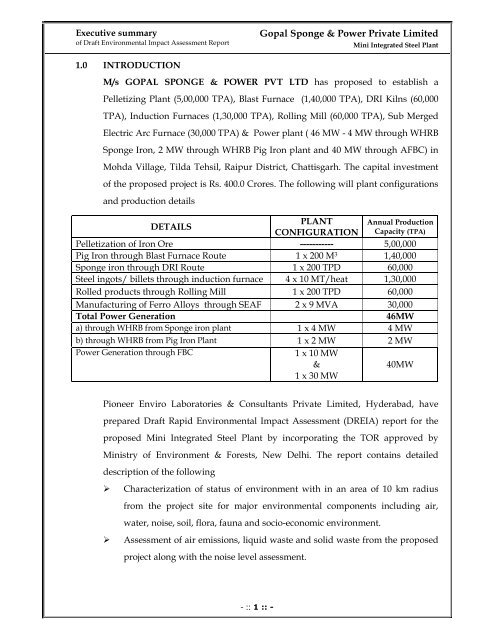
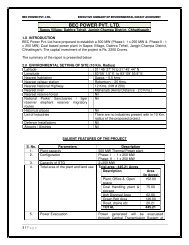

![ks= h; dk;kZy;] {ks= h; dk;kZy](https://img.yumpu.com/50492507/1/190x245/ks-h-dkkzy-ks-h-dkkzy.jpg?quality=85)
